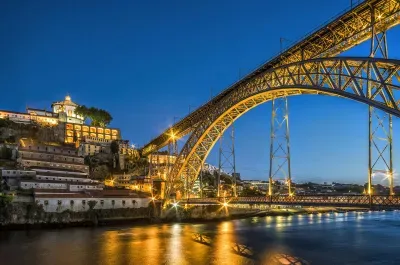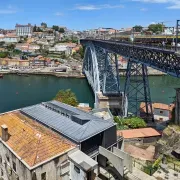
Situated on the far bank of the Douro from Porto's Ribeira district is Vila Nova de Gaia (or just Gaia). Despite its location Gaia is actually a city in its own right and extends quite some way from the riverside. Although being just at the other end of Porto's famous Dom Luis bridge this is a fairly arbitrary distinction for most visitors.
Generally speaking Vila Nova de Gaia is known for one thing - port. In fact this is where all the port wine in the world originates, and has done since the 17th century. Historically barrels of wine from the upper Douro Valley would be transported by boat to Gaia. Once here the wine would be taken to one of the port lodges that dominate the riverfront to be made into port. These days the barrels arrive by road, but the process is the same.

After maturing in the cool damp riverside cellars the wine is fortified by adding brandy (well not actually brandy but aguardente - a strong spirit made from grape husks). This halts the fermentation process, making the wine somewhat sweeter, and also increases the alcohol content. Delicious as this may taste it was originally produced to make the wine last on long voyages during a time when there was a trade embargo on French wines.
Three hundred years on and port wine is still Vila Nova de Gaia's biggest attraction. These days most visitors come to sample a glass or two at one of the numerous port lodges. There are in fact in excess of 60 port cellars here of which around 20 are open to the public. Familiar names such as Sandeman, Taylor's and Cálem all have tasting tours where you can familiarise yourself with ruby, white, tawny, vintage and crusted ports from a number of vintages.
If port isn't your thing then there are still a few good reasons to cross the river to Gaia and the best way to do this is by walking along the top deck of the Dom Luis bridge. Not only will this give you the best views of Porto to be had but it will deposit you right in the midst of Vila Nova de Gaia's finest attractions.

Overlooking everything in Gaia is a 17th century monastery, the Mosteiro da Serra de Pilar. This is the curiously round building that you can see from the Ribeira, and were probably wondering what it was! The circular portion of the building is the church, but there is also a seperate, equally round cloister. The complex was requisitioned by the Duke of Wellington during the Peninsula War in the early 1800s and has remained the property of the Portuguese military ever since. As a result the only way to look around the monastery is on the hourly guided tour.
Next door to the monastery is the palm-shaded Jardim do Morro. The gardens themselves are a pleasant spot to take some respite from the crowds of sightseers and there are some nicely landscaped features including a lake and cave. However, it is the views out over the river and Porto that make this really worth a visit, particularly at sunset when the river turns to gold.

An alternative, and very new, way to check out the view is by taking the Teleferico de Gaia. Running from next to the gardens and monastery and along the riverside the ride takes around five minutes as it whisks you 50 metres above the port lodges and terracotta roofs of Gaia. Possibly not one for those afraid of heights but the views over the Ribeira and back to the bridge.
It is worth taking the time to explore the maze of cobbled lanes and alleys beyond the main strip along the riverfront in Vila Nova de Gaia. Not only do they offer an escape from the crowds but provide a change of scene with some interesting sights. There are a couple of old churches in among the warehouses; the 14th century Igreja de Santa Marinha with its Baroque interior and the Convento de Corpus Christi which is now a venue for the arts.



